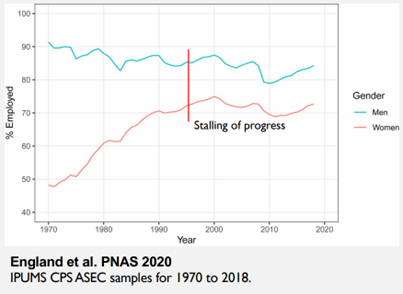Celebrating Women’s History Month
There is a lot to get excited about for the month of March – including March Madness, St. Patrick’s Day, Spring, Pi Day – but it is also the month to appreciate and celebrate women. National Women’s History Month started in 1987 when Congress designated it as an annual celebration. It began as a small-town initiative in California that slowly gained widespread recognition, but got its big boost when President Jimmy Carter learned about it and took action.
Celebrating Women’s History Month means different things to different people. For leaders in the business world, it is an opportunity to acknowledge a large segment of the workforce that has historically been marginalized.
While women have overtaken men and now account for more than half (50.7%) of the college-educated labor force in the US according to Pew Research Center, married or partnered heterosexual couples in the U.S continue to divide chores along largely traditional lines with the woman in the relationship shouldering primary responsibility for domestic chores including laundry, house cleaning, meal prep, and scheduling/planning. This is impacting women’s ability to move upward in the workforce. Organizations need to recognize that outside the business world, in our larger society, women are facing impediments to succeeding in the business world.
Although businesses have made progress, there is evidence that progress is both slower and less significant than people realize. According to Dr. Jill Yavorsky, there was notable progress for women from the mid-1990s to now. For example, in 1980 women held only 25% of all managerial roles and today they hold 40%. Similarly, the share of women board members in Fortune 500 companies has increased from 9.6% to 29% in 2022. However, Dr. Yavorsky also notes that the progress has been slowing down.
Dr. Yavorsky’s conclusions are supported by recent research performed by Chief, an executive women’s support organization. Chief’s research concludes that the pipeline for female leaders does not bode well for continued growth. Interestingly Chief’s research also highlights old stereotypes about women that persist. For example, close to half of male managers believe that women with children are less dedicated to their jobs than women without children. It’s interesting that research also seems to show that both men and women believe that the qualities of a good female leader are different from the qualities of a good male leader.
There is a lot that business leaders can do to mitigate disparities affecting women and to create a more equitable work environment with internal and external benefits. Internally, it can result in more engaged and satisfied workers, meaning less burnout and more innovation, and a larger available talent pool. Externally, it can help in promoting a company’s brand. Some actionable items a business can do today:
- Allow for flexibility of some type (whether that be schedule, location, and/or PTO).
- Allow for job sharing or lateral movements rather than vertical movements.
- Offer paid family leave (both maternity and paternity leave for 3 months) and have leaders set a precedent of using the leave.
- Formalize a mentorship and sponsoring program.
- Allow affinity groups to connect and form a network/community to discuss commonalities.
- Establish transparency for managers’ promotions and pay decisions.
While implementing all the above at once might be a tall order, attempting to offer these options to the women in your workplace may be a small step and have a big impact. Speaking from personal experience, Summit Leadership Partners treated me fairly and equitably with respect to my pregnancy shortly after I began to work there. While I had not been at the organization for more than a year, they still offered me 3 months of paid leave. This enabled me to come back energized and motivated with a feeling of loyalty and appreciation for the company I work for. It provided me with the time I needed to welcome a new member into my family and ensure that there is proper care lined up for when I went back to work so that I could continue to build my career and feed my ambition.
Without the leave, I would have returned before I was ready. I would have been sleep deprived. I would have had to juggle the care of an infant and produce quality work. This combination is often what leads many women to burn out and quit. Providing them with time to heal physically and mentally can also provide them with the chance to continue their careers as it has done for me. Women are continuing to educate themselves at a rapid pace, and weeding them out of the workforce by providing equal yet inequitable opportunities does not benefit society or organizations.
In my short time at Summit (slightly less than a year) I have facilitated presentations to organizations that support women in private equity and sat through think tanks with professors who study gender inequities for a living. Women are a talent pool that could be tapped into and mined for treasure if provided with equitable opportunities. Summit has partners that spend time studying the benefits of supporting women and understanding the historical inequities that exist and how to best approach them to benefit organizations. Summit is an organization that practices what they preach and are setting the example by being the example.
